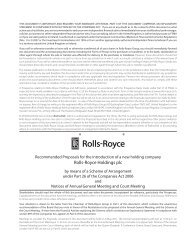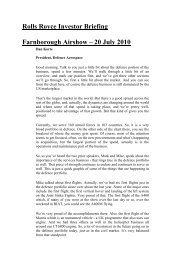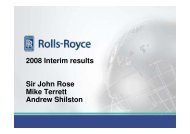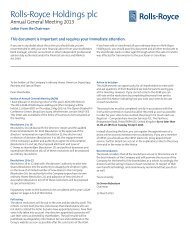Vision 2012/1 - Rolls-Royce
Vision 2012/1 - Rolls-Royce
Vision 2012/1 - Rolls-Royce
Create successful ePaper yourself
Turn your PDF publications into a flip-book with our unique Google optimized e-Paper software.
Emergencies always happen at the wrong time or<br />
in the wrong place, or both. Thanks to the new<br />
<strong>Rolls</strong>-<strong>Royce</strong> underwater service concept, most of<br />
the repairs and maintenance below the water line<br />
can now be done in the nearest harbour.<br />
There’s no need for dry docks or special facilities.<br />
Dedicated to keep<br />
vessels in service<br />
<br />
The underwater repair solutions offered by<br />
<strong>Rolls</strong>-<strong>Royce</strong> utilise key diving expertise to<br />
assist in repair and maintenance work below<br />
the water line, providing an alternative to<br />
drydocking. This means there is no need to<br />
sail to established repair ports or wait for a<br />
dry dock slot to become available, and it<br />
allows the vessel to remain on station while<br />
the work is being done.<br />
Since the first underwater repairs were<br />
undertaken in 2009, interest and enquiry<br />
levels continue to grow. By partnering with<br />
specialised diving expertise, <strong>Rolls</strong>-<strong>Royce</strong> is<br />
able to offer a comprehensive range of<br />
underwater services such as the tunnel<br />
thruster exchanges using the patented sled<br />
solution.<br />
“Underwater intervention service has<br />
changed the customers’ philosophy on<br />
emergency equipment repair, and the<br />
demand from clients in the offshore market<br />
has increased during the last few years.<br />
Our trusted diving partners benefit from the<br />
long experience of underwater repair in the<br />
shipping industry,” said Ole Jacob Irgens, SVP<br />
of Marine Services Customer Experience.<br />
<strong>Rolls</strong>-<strong>Royce</strong>, who, together with the<br />
specialised diving expertise, is developing<br />
innovative ways of working that are<br />
continually being tried and tested.<br />
Tunnel thruster exchange. The tunnel<br />
thruster was the first <strong>Rolls</strong>-<strong>Royce</strong> product to<br />
have an underwater repair solution<br />
developed for exchange. By using three<br />
special tools designed and patented by<br />
<strong>Rolls</strong>-<strong>Royce</strong>, and a simple sled, the complete<br />
unit can be removed and reinstalled in a<br />
floating vessel in under 12 hours. Sleds and<br />
exchange units are now available for the<br />
most popular tunnel thrusters in the<br />
<strong>Rolls</strong>-<strong>Royce</strong> range; TT1650, TT1850, TT2000,<br />
TT2400 and TT2650, as well as the TV150 and<br />
TV375. To minimise repair costs, <strong>Rolls</strong>-<strong>Royce</strong><br />
also provides thrusters from the exchange<br />
pool, which has been enlarged to meet the<br />
increased demand. When the exchange pool<br />
is used, the fully shop-tested and assembled<br />
unit can be commissioned quickly, cutting<br />
repair times from start to finish by over 50 per<br />
cent.<br />
Retractable azimuth thrusters. A way<br />
of moving and reinstalling <strong>Rolls</strong>-<strong>Royce</strong><br />
retractable azimuth thrusters without<br />
drydocking has been pioneered on Africa’s<br />
west coast. The unit was not originally<br />
designed for underwater removal.<br />
Creating a proper and safe dry environment<br />
around the affected thruster, <strong>Rolls</strong>-<strong>Royce</strong> had<br />
provided the turnkey solution. A hyperbaric<br />
environment was created by the dive teams,<br />
that allowed technicians and engineers to<br />
remove the unit from the ship while<br />
alongside a lay-by berth in West Africa. The<br />
unit was then overhauled by <strong>Rolls</strong>-<strong>Royce</strong>,<br />
refitted with diver support and<br />
commissioned. A conventional repair, with<br />
transit and waiting times would have taken<br />
around a month, but with the underwater<br />
repair solution the overall work took eight<br />
days. While the vessel was alongside, the<br />
ship’s crew prepared the vessel for its next<br />
contract, so no time was lost.<br />
20 VISION 1/12
















